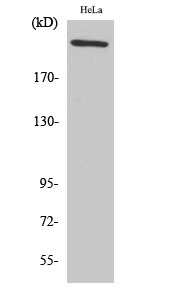Fibronectin antibody
GTX20299
ApplicationsImmunoFluorescence, ImmunoPrecipitation, Western Blot, ELISA, ImmunoCytoChemistry, ImmunoHistoChemistry, ImmunoHistoChemistry Paraffin
Product group Antibodies
ReactivityHuman
TargetFN1
Overview
- SupplierGeneTex
- Product NameFibronectin antibody
- Delivery Days Customer9
- Application Supplier NoteWB: 1:5000-1:10000. IHC-P: 1:50-1:200. IP: 1:100. ELISA: 1:5000-1:10000. *Optimal dilutions/concentrations should be determined by the researcher.Not tested in other applications.
- ApplicationsImmunoFluorescence, ImmunoPrecipitation, Western Blot, ELISA, ImmunoCytoChemistry, ImmunoHistoChemistry, ImmunoHistoChemistry Paraffin
- CertificationResearch Use Only
- ClonalityPolyclonal
- Concentration1 mg/ml
- ConjugateUnconjugated
- Gene ID2335
- Target nameFN1
- Target descriptionfibronectin 1
- Target synonymsCIG, ED-B, FINC, FN, FNZ, GFND, GFND2, LETS, MSF, SMDCF, fibronectin, cold-insoluble globulin, epididymis secretory sperm binding protein, lnc-ABCA12-8, migration-stimulating factor
- HostRabbit
- IsotypeIgG
- Protein IDP02751
- Protein NameFibronectin
- Scientific DescriptionFibronectin is a glycoprotein present in a soluble dimeric form in plasma, and in a dimeric or multimeric form at the cell surface and in extracellular matrix. Fibronectin is involved in cell adhesion and migration processes including embryogenesis, wound healing, blood coagulation, host defense, and metastasis. They occur as dimers of two 200 kDa subunits. They have binding domains for bacterial proteins, collagens, heparin-like molecules and fibrin. Cellular fibronectin is widely distributed in the stroma of malignant tumours.
- ReactivityHuman
- Storage Instruction-20°C or -80°C,2°C to 8°C
- UNSPSC12352203
References
- Wang SC, Sun HL, Hsu YH, et al. α-Linolenic acid inhibits the migration of human triple-negative breast cancer cells by attenuating Twist1 expression and suppressing Twist1-mediated epithelial-mesenchymal transition. Biochem Pharmacol. 2020,180:114152. doi: 10.1016/j.bcp.2020.114152Read this paper





![WB analysis of 25 ug of human plasma lysates using GTX15737 Fibronectin antibody [3F12]. Dilution : 1:300](https://www.genetex.com/upload/website/prouct_img/normal/GTX15737/GTX15737_1519_WB_w_23060620_400.webp)